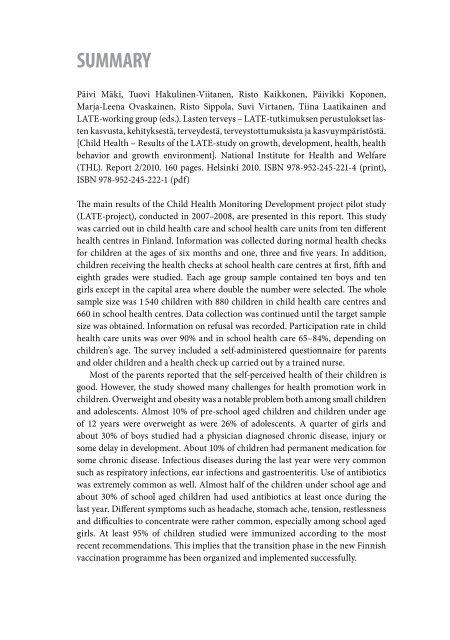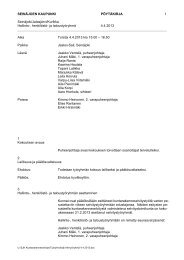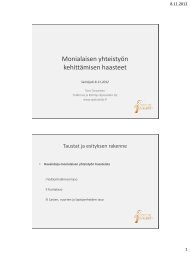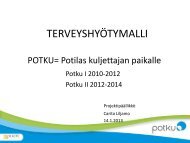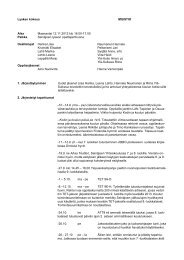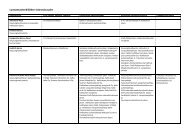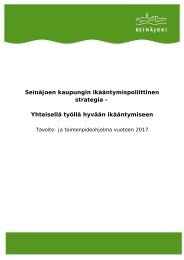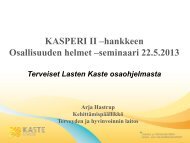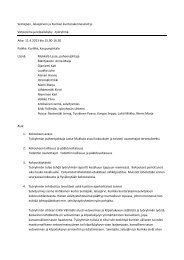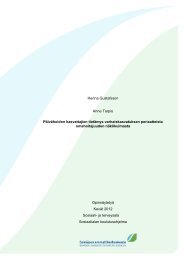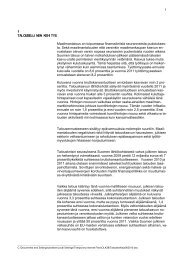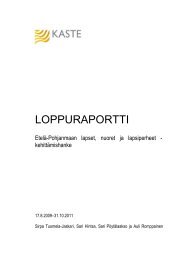Lasten terveys LATE-tutkimus
Lasten terveys LATE-tutkimus
Lasten terveys LATE-tutkimus
Create successful ePaper yourself
Turn your PDF publications into a flip-book with our unique Google optimized e-Paper software.
Summary<br />
Päivi Mäki, Tuovi Hakulinen-Viitanen, Risto Kaikkonen, Päivikki Koponen,<br />
Marja-Leena Ovaskainen, Risto Sippola, Suvi Virtanen, Tiina Laatikainen and<br />
<strong>LATE</strong>-working group (eds.). <strong>Lasten</strong> <strong>terveys</strong> – <strong>LATE</strong>-tutkimuksen perustulokset lasten<br />
kasvusta, kehityksestä, terveydestä, <strong>terveys</strong>tottumuksista ja kasvuympäristöstä.<br />
[Child Health – Results of the <strong>LATE</strong>-study on growth, development, health, health<br />
behavior and growth environment]. National Institute for Health and Welfare<br />
(THL). Report 2/2010. 160 pages. Helsinki 2010. ISBN 978-952-245-221-4 (print),<br />
ISBN 978-952-245-222-1 (pdf)<br />
The main results of the Child Health Monitoring Development project pilot study<br />
(<strong>LATE</strong>-project), conducted in 2007–2008, are presented in this report. This study<br />
was carried out in child health care and school health care units from ten different<br />
health centres in Finland. Information was collected during normal health checks<br />
for children at the ages of six months and one, three and five years. In addition,<br />
children receiving the health checks at school health care centres at first, fifth and<br />
eighth grades were studied. Each age group sample contained ten boys and ten<br />
girls except in the capital area where double the number were selected. The whole<br />
sample size was 1 540 children with 880 children in child health care centres and<br />
660 in school health centres. Data collection was continued until the target sample<br />
size was obtained. Information on refusal was recorded. Participation rate in child<br />
health care units was over 90% and in school health care 65–84%, depending on<br />
children’s age. The survey included a self-administered questionnaire for parents<br />
and older children and a health check up carried out by a trained nurse.<br />
Most of the parents reported that the self-perceived health of their children is<br />
good. However, the study showed many challenges for health promotion work in<br />
children. Overweight and obesity was a notable problem both among small children<br />
and adolescents. Almost 10% of pre-school aged children and children under age<br />
of 12 years were overweight as were 26% of adolescents. A quarter of girls and<br />
about 30% of boys studied had a physician diagnosed chronic disease, injury or<br />
some delay in development. About 10% of children had permanent medication for<br />
some chronic disease. Infectious diseases during the last year were very common<br />
such as respiratory infections, ear infections and gastroenteritis. Use of antibiotics<br />
was extremely common as well. Almost half of the children under school age and<br />
about 30% of school aged children had used antibiotics at least once during the<br />
last year. Different symptoms such as headache, stomach ache, tension, restlessness<br />
and difficulties to concentrate were rather common, especially among school aged<br />
girls. At least 95% of children studied were immunized according to the most<br />
recent recommendations. This implies that the transition phase in the new Finnish<br />
vaccination programme has been organized and implemented successfully.


